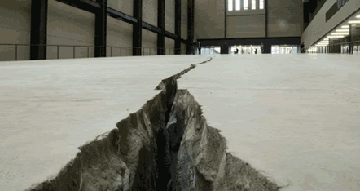
Doris Salcedo, "Shibboleth," 2007. Photo: Tate Modern.
A friend of mine told me how she first learned of rape: rape happens when someone forces all your clothes off, her brother explained. My friend was, of course, horrified.
I learned about rape at the Sauk County Fair. I picked up a graphic novel at a booth, and, while I don’t remember the novel at all, I remember one phrase from the author’s biography: “raped at knifepoint.” She had been a young black woman and the one with the knife had been a white man. I imagined it happening in a barn (in the filmy, strangely accurate way I understood white-on-black violence, farms were emblematic sites), though I didn’t really know what it was. I did vaguely understand that her subsequent pregnancy meant the legacy of what happened would probably outlive her.
It’s difficult to understand the pain of others. Even now, I still often think of rape as silently happening in rural places, leading to new lives that will be tacitly ignored by those of us who weren’t there.
Art is at its most incisive when it breaks into that chasm between our own misunderstandings and the pervasive pain we don’t know how to acknowledge. Though I saw Doris Salcedo’s Shibboleth, an austere fissure that split into the foundation of the Tate Modern’s Turbine Hall, only in photographs, I felt it acknowledged the difficulty of compassion with penetrating accuracy.
Salcedo works in an aloof way. Yet she’s always gutturally grappling with the most emotive and threatening sides of life—piling wooden chairs in an alley in such a way that makes death absurd and daunting, filling furniture with concrete to commemorate people whose lives have been made irrationally inert, or breaking open the floor of the Tate Modern. She responds to explicit problems—political violence in her native Colombia or racism in the post-colonial world—but her work has wide ramifications.
At first glance, Shibboleth struck me as a cold Minimalist ploy, a Richard-Serra-like testament to the power of single physical gestures. And I suppose it is cold and minimal. But watching a video of visitors stepping over and around the fissure, becoming inadvertently separated from each other, unable to close the gulf and unsure of how to navigate it, emphasized the fragility of our understanding of ourselves. What is compassion? How close can we really get to someone else’s pain? What we do once we’ve witnessed trauma?
After immersing herself in the pain of others, Salcedo has emerged with inert, gapingly industrial gestures. Cold and mute like architectural ruins, they give compassion a pragmatic face.



